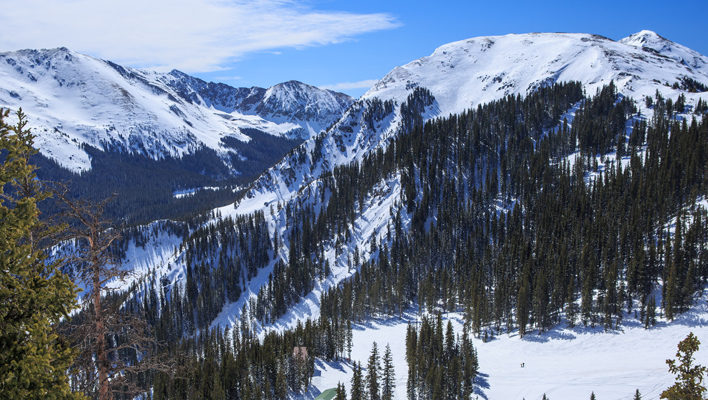An avalanche at Taos Ski Valley, New Mexico on Thursday, January 20 took the lives of two skiers. The accident occurred inbounds on Kachina Peak, terrain that had opened for the season earlier in the week.

Kachina Peak, the rounded summit beyond the treed ridge, in its pre-lift-served days. [Photo] Murray Foubister
Following transportation via ambulance to Holy Cross Hospital in Taos, one of the men involved in the avalanche died on Thursday evening, the hospital’s CEO, Bill Patten, confirmed to the Associated Press. According to KOAT Albuquerque, the family identified the deceased as Matthew Zonghetti of Mansfield, Massachusetts.
Zonghetti, age 26 and a lifelong skier, reportedly took annual ski trips with his father, Mike Zonghetti, who was at the mountain’s base when the avalanche occurred. “We had been to just about every ski resort in the United States,” the elder Zonghetti told the Boston Globe of trips he’d taken with his son, who’d recently moved to Denver to pursue a job in real estate. “He was kind of a parent’s dream…. Terrific, terrific young man.”
On Monday, January 21, the family of the second skier, Corey Borg-Massanari, confirmed his death at the University of New Mexico Hospital in Albuquerque, to where he was airlifted following the accident. Borg-Massanari, 22, was born in Pueblo, Colo., grew up in Brainerd, Minnesota and was attending Colorado Mountain College in Glenwood Springs at the time of the avalanche, according to a statement released by his family. “Corey was an experienced and avid skier and loved the outdoors,” his family’s statement said. “Corey was known for his smile, his quirky sense of humor and his unique sense of style.”
The Kachina Peak Lift, installed in 2015 to access a previously off-piste portion of the mountain, opened for the season on Tuesday, January 15. According to Taos’s Twitter account, Kachina Peak’s terrain remained closed last Wednesday due to low visibility, but opened Thursday morning following avalanche control work by ski patrol. “Avalanche mitigation work has been taking place throughout the season and as recently as this morning in the area that the avalanche occurred,” the Taos press release confirmed.
Taos reported 15 inches of snow over the weekend leading up to the accident and another two inches of accumulation on the prior Wednesday. Avalanche danger for the region has remained unreported, however, after the Taos Avalanche Center’s closing last winter.
The accident that claimed the lives of Zonghetti and Borg-Massanari follows the death of Peter Marshall, a participant in an avalanche safety course on Colorado’s Red Mountain Pass in early January, the first avalanche fatality of a skier in the U.S. this season. Two more accidents over the weekend—in Utah’s Electric Lake region and near Aspen, Colo.’s Markley Hut—raise the season total of skier fatalities in the U.S. to five.
Here’s Taos Ski Valley’s press release from the accident in full from Thursday, January 17.
Shortly after 11:30 a.m. today, an in-bounds avalanche occurred on the K3 chute off of Kachina Peak at Taos Ski Valley. The ski patrol and nearby witnesses immediately responded to the scene and rescued two skiers who had been buried by snow. The skiers received medical attention at the ski valley and were then swiftly transported to local medical facilities. We do not yet have an update on their medical conditions or identities.
The ski patrol has cleared the area after an exhaustive search using the latest avalanche response protocol. There are no additional people involved.
Avalanche mitigation work has been taking place throughout the season and as recently as this morning in the area that the avalanche occurred.
Our thoughts and prayers are with the two individuals who were affected by today’s event and their families. We are grateful to the ski patrol and community of visitors across the mountain who responded without hesitation to rescue these individuals. We appreciate the overwhelming support of the community during this incident.
—
This story was updated on Tuesday, January 20.









Related posts: